Leadership Styles and Change Management Report - BC415014S, Semester
VerifiedAdded on 2023/06/10
|17
|4566
|286
Report
AI Summary
This report delves into the concepts of leadership and change management, presenting a comprehensive analysis of leadership styles and their practical application. Task A offers a reflective account of the student's leadership experience within a project management team, evaluating their effectiveness using relevant leadership theories like situational and transformational leadership. The student identifies strengths, weaknesses, and areas for improvement, providing recommendations for future leadership roles. Task B presents a case study on BBC Worldwide, examining the organization's change process and its objectives. The report analyzes the implemented change strategies, evaluates their outcomes, and extracts key lessons learned. The report integrates theoretical frameworks with practical examples, offering insights into effective leadership and change management practices.
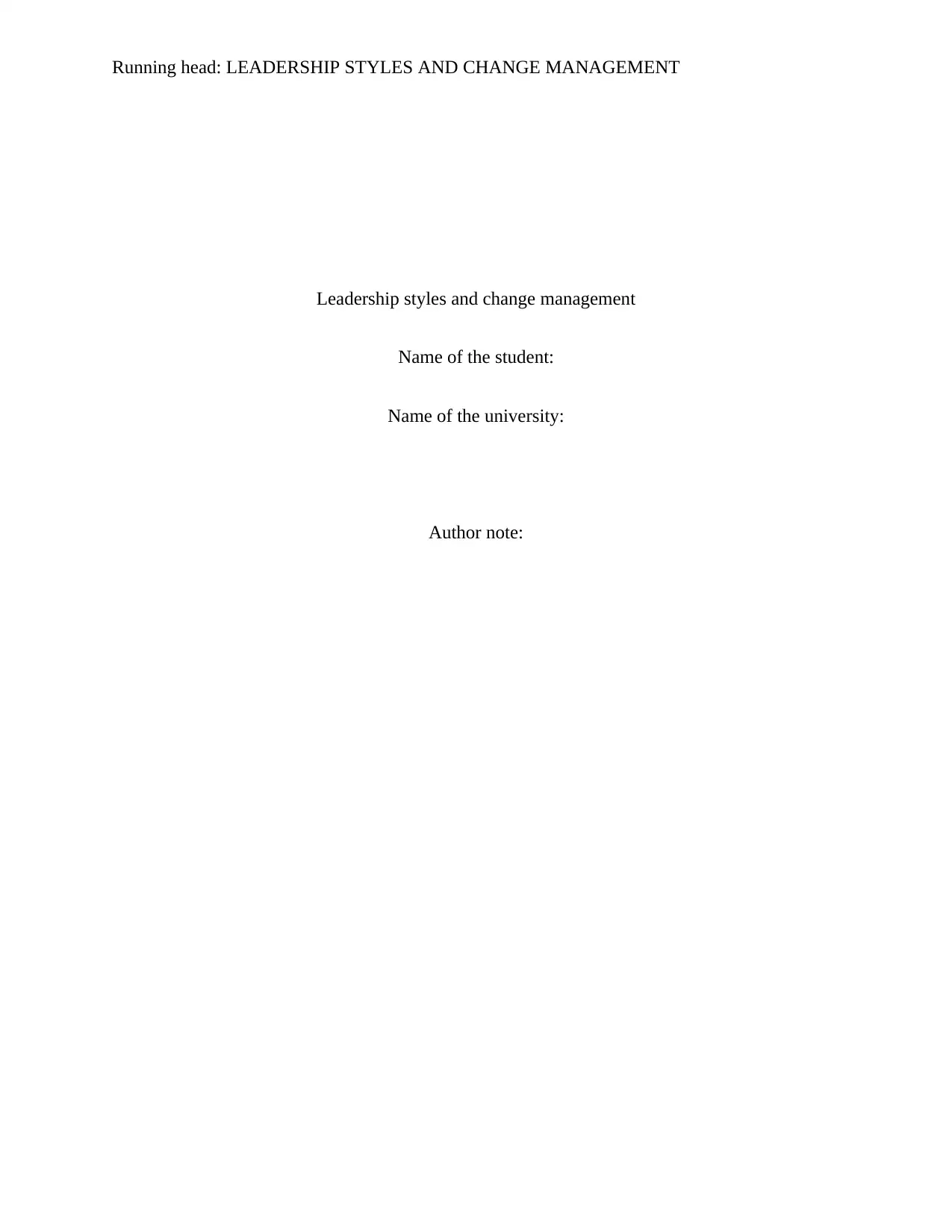
Running head: LEADERSHIP STYLES AND CHANGE MANAGEMENT
Leadership styles and change management
Name of the student:
Name of the university:
Author note:
Leadership styles and change management
Name of the student:
Name of the university:
Author note:
Paraphrase This Document
Need a fresh take? Get an instant paraphrase of this document with our AI Paraphraser

1LEADERSHIP STYLES AND CHANGE MANAGEMENT
Executive summary
The aim of this report is to study the concept of leadership and change; leadership, as a practical
skill, includes several aspects like styles of leadership and models pertaining to the same.
Similarly, change theory refers to the way in which an organization implements change into its
operations, and the teamwork that goes into it. The paper can be divided into two segments; the
first part is a reflective account of my stint as the leader of a project management team at an
esteemed organization and the second part includes a case study on BBC Worldwide, and the
change theory that was implemented in the organization. Leadership may be defined as the way
an individual leads other individuals towards progress. To analyze the essential qualities of an
effective leader, both personal and professional traits have been discussed in the report.
Moreover, the implications of change management and implementation of change process at an
organization have been examined.
Executive summary
The aim of this report is to study the concept of leadership and change; leadership, as a practical
skill, includes several aspects like styles of leadership and models pertaining to the same.
Similarly, change theory refers to the way in which an organization implements change into its
operations, and the teamwork that goes into it. The paper can be divided into two segments; the
first part is a reflective account of my stint as the leader of a project management team at an
esteemed organization and the second part includes a case study on BBC Worldwide, and the
change theory that was implemented in the organization. Leadership may be defined as the way
an individual leads other individuals towards progress. To analyze the essential qualities of an
effective leader, both personal and professional traits have been discussed in the report.
Moreover, the implications of change management and implementation of change process at an
organization have been examined.
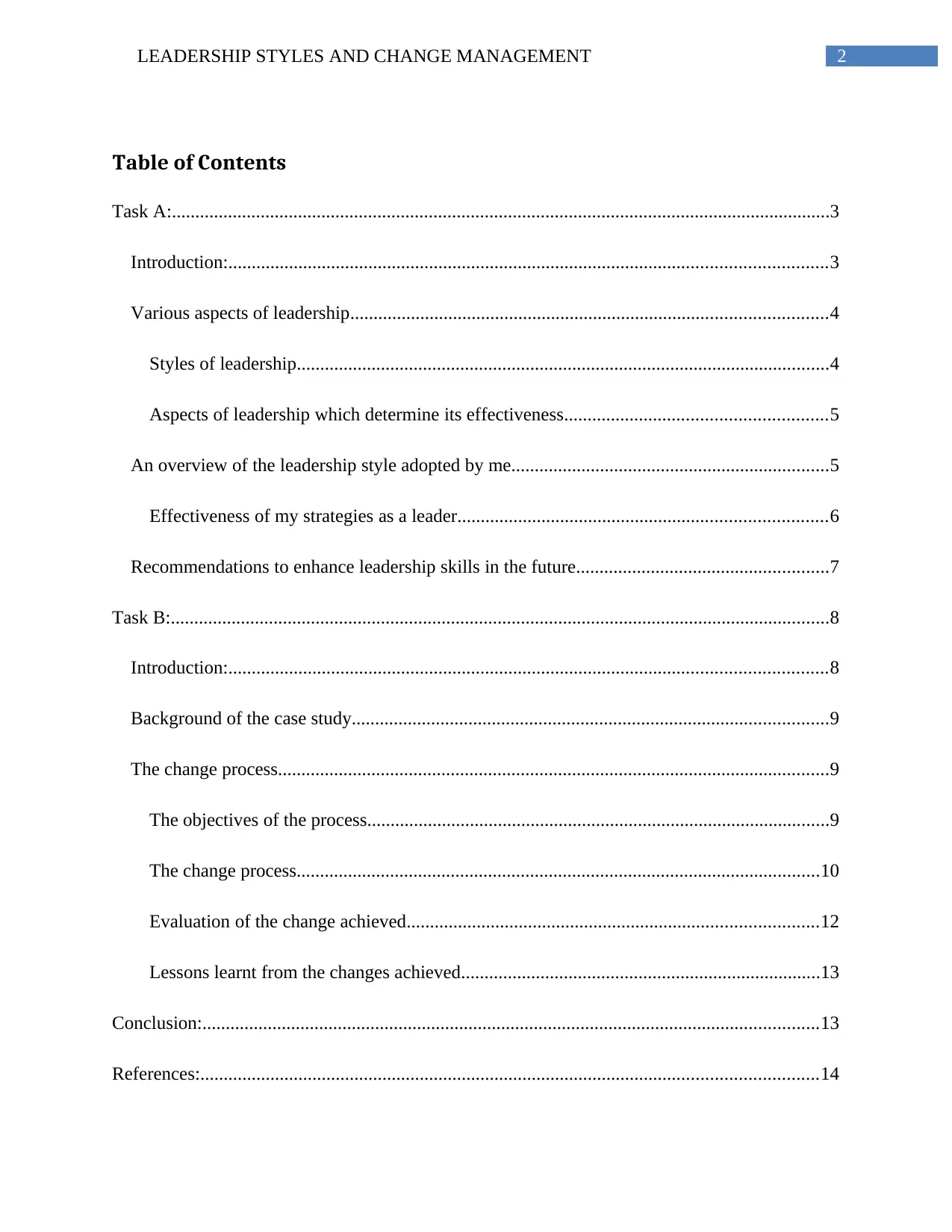
2LEADERSHIP STYLES AND CHANGE MANAGEMENT
Table of Contents
Task A:.............................................................................................................................................3
Introduction:................................................................................................................................3
Various aspects of leadership......................................................................................................4
Styles of leadership..................................................................................................................4
Aspects of leadership which determine its effectiveness........................................................5
An overview of the leadership style adopted by me....................................................................5
Effectiveness of my strategies as a leader...............................................................................6
Recommendations to enhance leadership skills in the future......................................................7
Task B:.............................................................................................................................................8
Introduction:................................................................................................................................8
Background of the case study......................................................................................................9
The change process......................................................................................................................9
The objectives of the process...................................................................................................9
The change process................................................................................................................10
Evaluation of the change achieved........................................................................................12
Lessons learnt from the changes achieved.............................................................................13
Conclusion:....................................................................................................................................13
References:....................................................................................................................................14
Table of Contents
Task A:.............................................................................................................................................3
Introduction:................................................................................................................................3
Various aspects of leadership......................................................................................................4
Styles of leadership..................................................................................................................4
Aspects of leadership which determine its effectiveness........................................................5
An overview of the leadership style adopted by me....................................................................5
Effectiveness of my strategies as a leader...............................................................................6
Recommendations to enhance leadership skills in the future......................................................7
Task B:.............................................................................................................................................8
Introduction:................................................................................................................................8
Background of the case study......................................................................................................9
The change process......................................................................................................................9
The objectives of the process...................................................................................................9
The change process................................................................................................................10
Evaluation of the change achieved........................................................................................12
Lessons learnt from the changes achieved.............................................................................13
Conclusion:....................................................................................................................................13
References:....................................................................................................................................14
⊘ This is a preview!⊘
Do you want full access?
Subscribe today to unlock all pages.

Trusted by 1+ million students worldwide
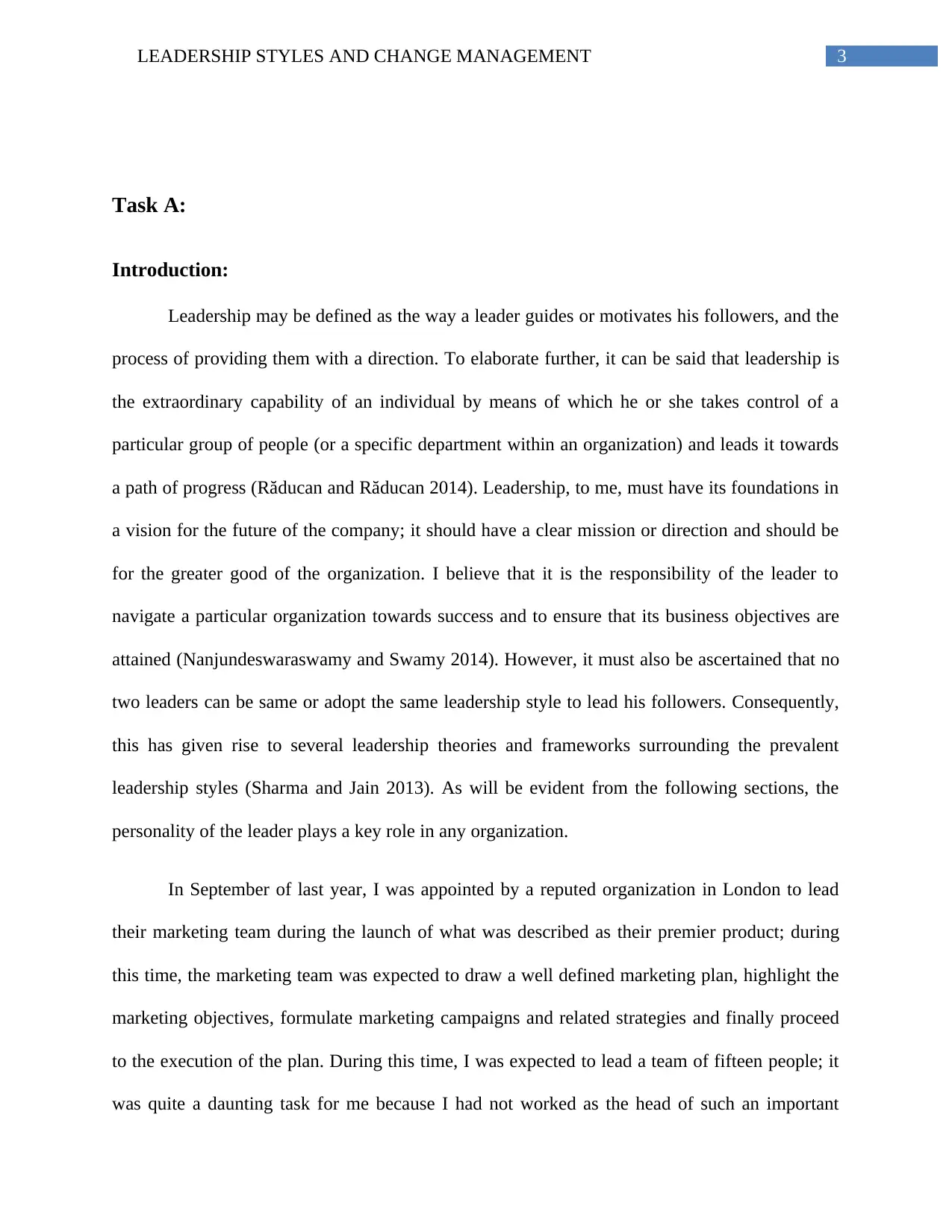
3LEADERSHIP STYLES AND CHANGE MANAGEMENT
Task A:
Introduction:
Leadership may be defined as the way a leader guides or motivates his followers, and the
process of providing them with a direction. To elaborate further, it can be said that leadership is
the extraordinary capability of an individual by means of which he or she takes control of a
particular group of people (or a specific department within an organization) and leads it towards
a path of progress (Răducan and Răducan 2014). Leadership, to me, must have its foundations in
a vision for the future of the company; it should have a clear mission or direction and should be
for the greater good of the organization. I believe that it is the responsibility of the leader to
navigate a particular organization towards success and to ensure that its business objectives are
attained (Nanjundeswaraswamy and Swamy 2014). However, it must also be ascertained that no
two leaders can be same or adopt the same leadership style to lead his followers. Consequently,
this has given rise to several leadership theories and frameworks surrounding the prevalent
leadership styles (Sharma and Jain 2013). As will be evident from the following sections, the
personality of the leader plays a key role in any organization.
In September of last year, I was appointed by a reputed organization in London to lead
their marketing team during the launch of what was described as their premier product; during
this time, the marketing team was expected to draw a well defined marketing plan, highlight the
marketing objectives, formulate marketing campaigns and related strategies and finally proceed
to the execution of the plan. During this time, I was expected to lead a team of fifteen people; it
was quite a daunting task for me because I had not worked as the head of such an important
Task A:
Introduction:
Leadership may be defined as the way a leader guides or motivates his followers, and the
process of providing them with a direction. To elaborate further, it can be said that leadership is
the extraordinary capability of an individual by means of which he or she takes control of a
particular group of people (or a specific department within an organization) and leads it towards
a path of progress (Răducan and Răducan 2014). Leadership, to me, must have its foundations in
a vision for the future of the company; it should have a clear mission or direction and should be
for the greater good of the organization. I believe that it is the responsibility of the leader to
navigate a particular organization towards success and to ensure that its business objectives are
attained (Nanjundeswaraswamy and Swamy 2014). However, it must also be ascertained that no
two leaders can be same or adopt the same leadership style to lead his followers. Consequently,
this has given rise to several leadership theories and frameworks surrounding the prevalent
leadership styles (Sharma and Jain 2013). As will be evident from the following sections, the
personality of the leader plays a key role in any organization.
In September of last year, I was appointed by a reputed organization in London to lead
their marketing team during the launch of what was described as their premier product; during
this time, the marketing team was expected to draw a well defined marketing plan, highlight the
marketing objectives, formulate marketing campaigns and related strategies and finally proceed
to the execution of the plan. During this time, I was expected to lead a team of fifteen people; it
was quite a daunting task for me because I had not worked as the head of such an important
Paraphrase This Document
Need a fresh take? Get an instant paraphrase of this document with our AI Paraphraser
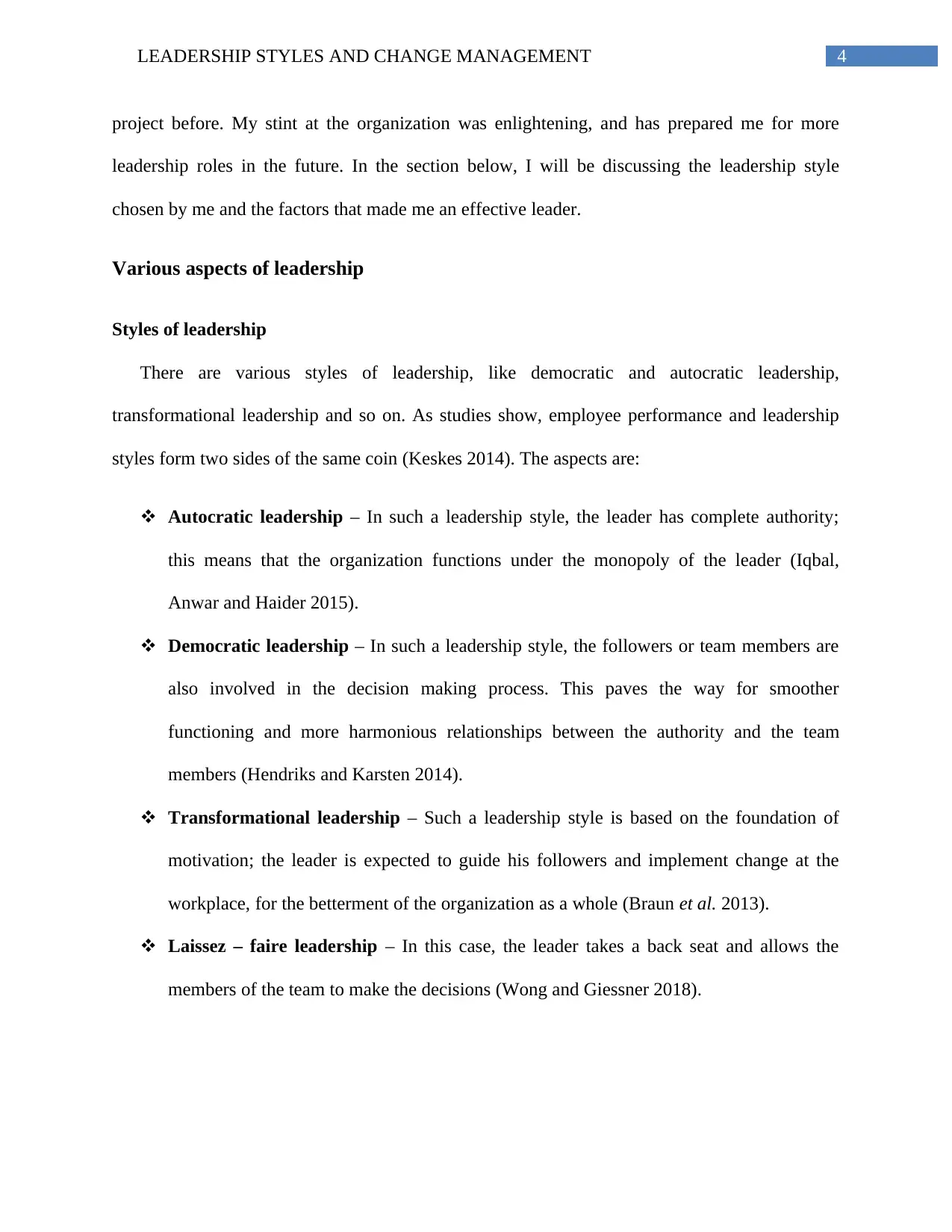
4LEADERSHIP STYLES AND CHANGE MANAGEMENT
project before. My stint at the organization was enlightening, and has prepared me for more
leadership roles in the future. In the section below, I will be discussing the leadership style
chosen by me and the factors that made me an effective leader.
Various aspects of leadership
Styles of leadership
There are various styles of leadership, like democratic and autocratic leadership,
transformational leadership and so on. As studies show, employee performance and leadership
styles form two sides of the same coin (Keskes 2014). The aspects are:
Autocratic leadership – In such a leadership style, the leader has complete authority;
this means that the organization functions under the monopoly of the leader (Iqbal,
Anwar and Haider 2015).
Democratic leadership – In such a leadership style, the followers or team members are
also involved in the decision making process. This paves the way for smoother
functioning and more harmonious relationships between the authority and the team
members (Hendriks and Karsten 2014).
Transformational leadership – Such a leadership style is based on the foundation of
motivation; the leader is expected to guide his followers and implement change at the
workplace, for the betterment of the organization as a whole (Braun et al. 2013).
Laissez – faire leadership – In this case, the leader takes a back seat and allows the
members of the team to make the decisions (Wong and Giessner 2018).
project before. My stint at the organization was enlightening, and has prepared me for more
leadership roles in the future. In the section below, I will be discussing the leadership style
chosen by me and the factors that made me an effective leader.
Various aspects of leadership
Styles of leadership
There are various styles of leadership, like democratic and autocratic leadership,
transformational leadership and so on. As studies show, employee performance and leadership
styles form two sides of the same coin (Keskes 2014). The aspects are:
Autocratic leadership – In such a leadership style, the leader has complete authority;
this means that the organization functions under the monopoly of the leader (Iqbal,
Anwar and Haider 2015).
Democratic leadership – In such a leadership style, the followers or team members are
also involved in the decision making process. This paves the way for smoother
functioning and more harmonious relationships between the authority and the team
members (Hendriks and Karsten 2014).
Transformational leadership – Such a leadership style is based on the foundation of
motivation; the leader is expected to guide his followers and implement change at the
workplace, for the betterment of the organization as a whole (Braun et al. 2013).
Laissez – faire leadership – In this case, the leader takes a back seat and allows the
members of the team to make the decisions (Wong and Giessner 2018).
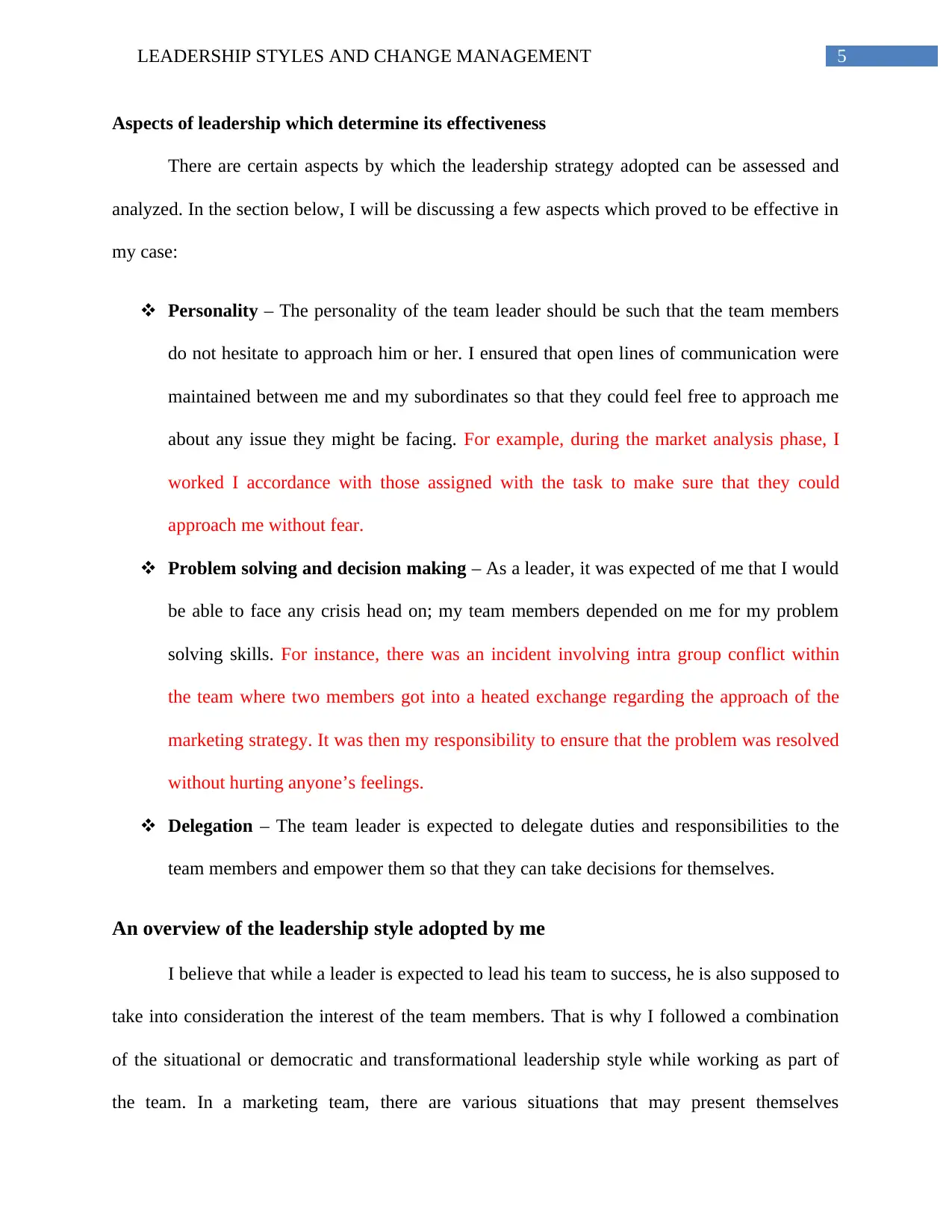
5LEADERSHIP STYLES AND CHANGE MANAGEMENT
Aspects of leadership which determine its effectiveness
There are certain aspects by which the leadership strategy adopted can be assessed and
analyzed. In the section below, I will be discussing a few aspects which proved to be effective in
my case:
Personality – The personality of the team leader should be such that the team members
do not hesitate to approach him or her. I ensured that open lines of communication were
maintained between me and my subordinates so that they could feel free to approach me
about any issue they might be facing. For example, during the market analysis phase, I
worked I accordance with those assigned with the task to make sure that they could
approach me without fear.
Problem solving and decision making – As a leader, it was expected of me that I would
be able to face any crisis head on; my team members depended on me for my problem
solving skills. For instance, there was an incident involving intra group conflict within
the team where two members got into a heated exchange regarding the approach of the
marketing strategy. It was then my responsibility to ensure that the problem was resolved
without hurting anyone’s feelings.
Delegation – The team leader is expected to delegate duties and responsibilities to the
team members and empower them so that they can take decisions for themselves.
An overview of the leadership style adopted by me
I believe that while a leader is expected to lead his team to success, he is also supposed to
take into consideration the interest of the team members. That is why I followed a combination
of the situational or democratic and transformational leadership style while working as part of
the team. In a marketing team, there are various situations that may present themselves
Aspects of leadership which determine its effectiveness
There are certain aspects by which the leadership strategy adopted can be assessed and
analyzed. In the section below, I will be discussing a few aspects which proved to be effective in
my case:
Personality – The personality of the team leader should be such that the team members
do not hesitate to approach him or her. I ensured that open lines of communication were
maintained between me and my subordinates so that they could feel free to approach me
about any issue they might be facing. For example, during the market analysis phase, I
worked I accordance with those assigned with the task to make sure that they could
approach me without fear.
Problem solving and decision making – As a leader, it was expected of me that I would
be able to face any crisis head on; my team members depended on me for my problem
solving skills. For instance, there was an incident involving intra group conflict within
the team where two members got into a heated exchange regarding the approach of the
marketing strategy. It was then my responsibility to ensure that the problem was resolved
without hurting anyone’s feelings.
Delegation – The team leader is expected to delegate duties and responsibilities to the
team members and empower them so that they can take decisions for themselves.
An overview of the leadership style adopted by me
I believe that while a leader is expected to lead his team to success, he is also supposed to
take into consideration the interest of the team members. That is why I followed a combination
of the situational or democratic and transformational leadership style while working as part of
the team. In a marketing team, there are various situations that may present themselves
⊘ This is a preview!⊘
Do you want full access?
Subscribe today to unlock all pages.

Trusted by 1+ million students worldwide
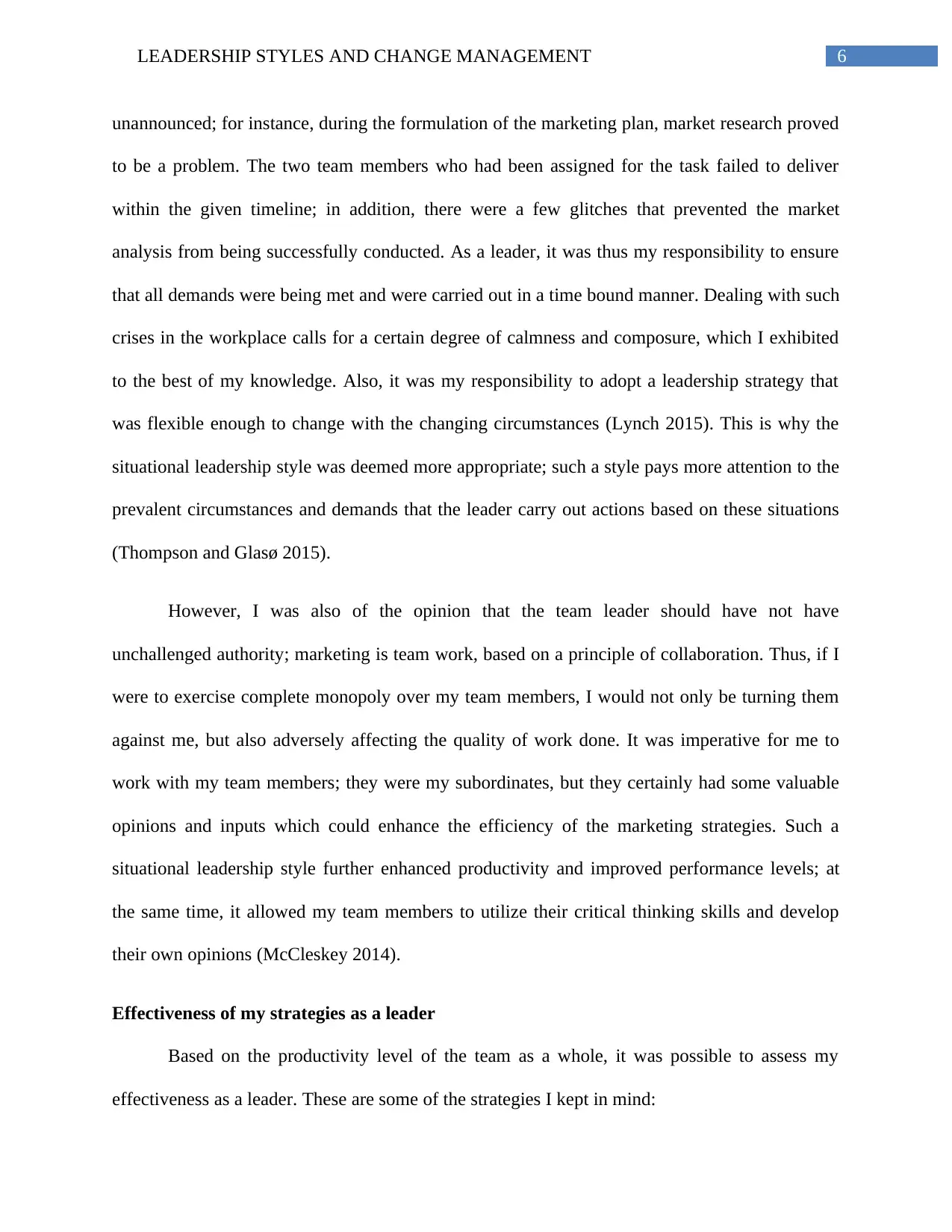
6LEADERSHIP STYLES AND CHANGE MANAGEMENT
unannounced; for instance, during the formulation of the marketing plan, market research proved
to be a problem. The two team members who had been assigned for the task failed to deliver
within the given timeline; in addition, there were a few glitches that prevented the market
analysis from being successfully conducted. As a leader, it was thus my responsibility to ensure
that all demands were being met and were carried out in a time bound manner. Dealing with such
crises in the workplace calls for a certain degree of calmness and composure, which I exhibited
to the best of my knowledge. Also, it was my responsibility to adopt a leadership strategy that
was flexible enough to change with the changing circumstances (Lynch 2015). This is why the
situational leadership style was deemed more appropriate; such a style pays more attention to the
prevalent circumstances and demands that the leader carry out actions based on these situations
(Thompson and Glasø 2015).
However, I was also of the opinion that the team leader should have not have
unchallenged authority; marketing is team work, based on a principle of collaboration. Thus, if I
were to exercise complete monopoly over my team members, I would not only be turning them
against me, but also adversely affecting the quality of work done. It was imperative for me to
work with my team members; they were my subordinates, but they certainly had some valuable
opinions and inputs which could enhance the efficiency of the marketing strategies. Such a
situational leadership style further enhanced productivity and improved performance levels; at
the same time, it allowed my team members to utilize their critical thinking skills and develop
their own opinions (McCleskey 2014).
Effectiveness of my strategies as a leader
Based on the productivity level of the team as a whole, it was possible to assess my
effectiveness as a leader. These are some of the strategies I kept in mind:
unannounced; for instance, during the formulation of the marketing plan, market research proved
to be a problem. The two team members who had been assigned for the task failed to deliver
within the given timeline; in addition, there were a few glitches that prevented the market
analysis from being successfully conducted. As a leader, it was thus my responsibility to ensure
that all demands were being met and were carried out in a time bound manner. Dealing with such
crises in the workplace calls for a certain degree of calmness and composure, which I exhibited
to the best of my knowledge. Also, it was my responsibility to adopt a leadership strategy that
was flexible enough to change with the changing circumstances (Lynch 2015). This is why the
situational leadership style was deemed more appropriate; such a style pays more attention to the
prevalent circumstances and demands that the leader carry out actions based on these situations
(Thompson and Glasø 2015).
However, I was also of the opinion that the team leader should have not have
unchallenged authority; marketing is team work, based on a principle of collaboration. Thus, if I
were to exercise complete monopoly over my team members, I would not only be turning them
against me, but also adversely affecting the quality of work done. It was imperative for me to
work with my team members; they were my subordinates, but they certainly had some valuable
opinions and inputs which could enhance the efficiency of the marketing strategies. Such a
situational leadership style further enhanced productivity and improved performance levels; at
the same time, it allowed my team members to utilize their critical thinking skills and develop
their own opinions (McCleskey 2014).
Effectiveness of my strategies as a leader
Based on the productivity level of the team as a whole, it was possible to assess my
effectiveness as a leader. These are some of the strategies I kept in mind:
Paraphrase This Document
Need a fresh take? Get an instant paraphrase of this document with our AI Paraphraser
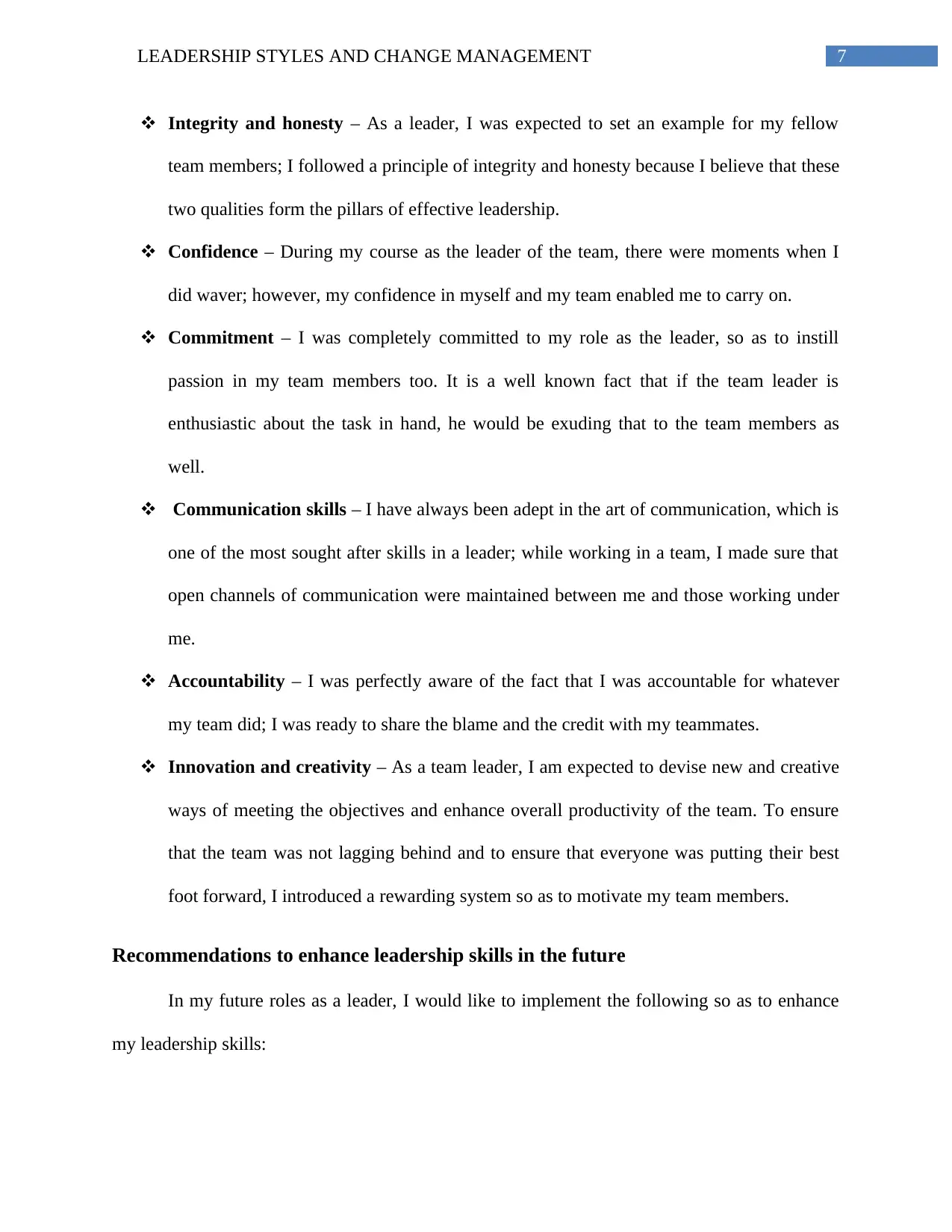
7LEADERSHIP STYLES AND CHANGE MANAGEMENT
Integrity and honesty – As a leader, I was expected to set an example for my fellow
team members; I followed a principle of integrity and honesty because I believe that these
two qualities form the pillars of effective leadership.
Confidence – During my course as the leader of the team, there were moments when I
did waver; however, my confidence in myself and my team enabled me to carry on.
Commitment – I was completely committed to my role as the leader, so as to instill
passion in my team members too. It is a well known fact that if the team leader is
enthusiastic about the task in hand, he would be exuding that to the team members as
well.
Communication skills – I have always been adept in the art of communication, which is
one of the most sought after skills in a leader; while working in a team, I made sure that
open channels of communication were maintained between me and those working under
me.
Accountability – I was perfectly aware of the fact that I was accountable for whatever
my team did; I was ready to share the blame and the credit with my teammates.
Innovation and creativity – As a team leader, I am expected to devise new and creative
ways of meeting the objectives and enhance overall productivity of the team. To ensure
that the team was not lagging behind and to ensure that everyone was putting their best
foot forward, I introduced a rewarding system so as to motivate my team members.
Recommendations to enhance leadership skills in the future
In my future roles as a leader, I would like to implement the following so as to enhance
my leadership skills:
Integrity and honesty – As a leader, I was expected to set an example for my fellow
team members; I followed a principle of integrity and honesty because I believe that these
two qualities form the pillars of effective leadership.
Confidence – During my course as the leader of the team, there were moments when I
did waver; however, my confidence in myself and my team enabled me to carry on.
Commitment – I was completely committed to my role as the leader, so as to instill
passion in my team members too. It is a well known fact that if the team leader is
enthusiastic about the task in hand, he would be exuding that to the team members as
well.
Communication skills – I have always been adept in the art of communication, which is
one of the most sought after skills in a leader; while working in a team, I made sure that
open channels of communication were maintained between me and those working under
me.
Accountability – I was perfectly aware of the fact that I was accountable for whatever
my team did; I was ready to share the blame and the credit with my teammates.
Innovation and creativity – As a team leader, I am expected to devise new and creative
ways of meeting the objectives and enhance overall productivity of the team. To ensure
that the team was not lagging behind and to ensure that everyone was putting their best
foot forward, I introduced a rewarding system so as to motivate my team members.
Recommendations to enhance leadership skills in the future
In my future roles as a leader, I would like to implement the following so as to enhance
my leadership skills:
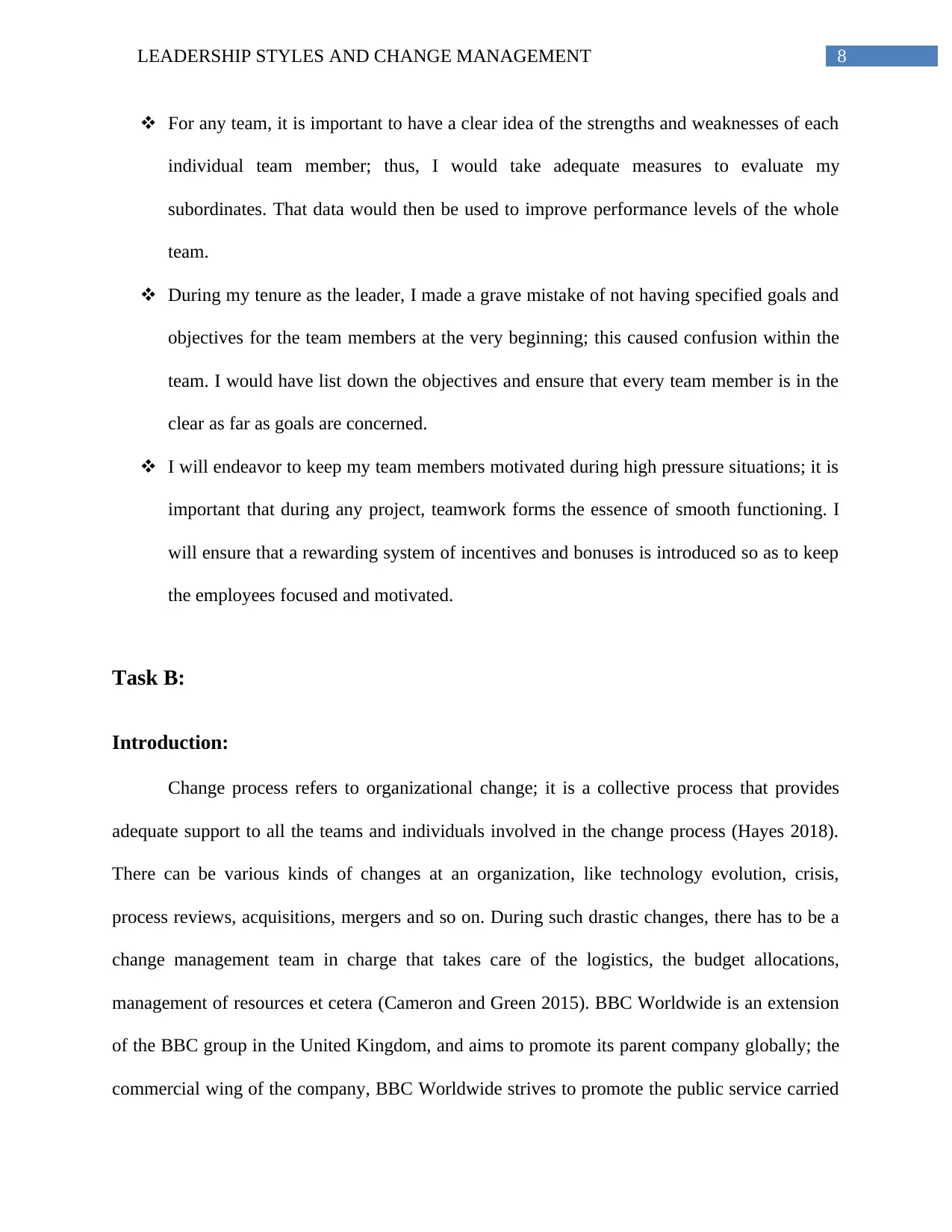
8LEADERSHIP STYLES AND CHANGE MANAGEMENT
For any team, it is important to have a clear idea of the strengths and weaknesses of each
individual team member; thus, I would take adequate measures to evaluate my
subordinates. That data would then be used to improve performance levels of the whole
team.
During my tenure as the leader, I made a grave mistake of not having specified goals and
objectives for the team members at the very beginning; this caused confusion within the
team. I would have list down the objectives and ensure that every team member is in the
clear as far as goals are concerned.
I will endeavor to keep my team members motivated during high pressure situations; it is
important that during any project, teamwork forms the essence of smooth functioning. I
will ensure that a rewarding system of incentives and bonuses is introduced so as to keep
the employees focused and motivated.
Task B:
Introduction:
Change process refers to organizational change; it is a collective process that provides
adequate support to all the teams and individuals involved in the change process (Hayes 2018).
There can be various kinds of changes at an organization, like technology evolution, crisis,
process reviews, acquisitions, mergers and so on. During such drastic changes, there has to be a
change management team in charge that takes care of the logistics, the budget allocations,
management of resources et cetera (Cameron and Green 2015). BBC Worldwide is an extension
of the BBC group in the United Kingdom, and aims to promote its parent company globally; the
commercial wing of the company, BBC Worldwide strives to promote the public service carried
For any team, it is important to have a clear idea of the strengths and weaknesses of each
individual team member; thus, I would take adequate measures to evaluate my
subordinates. That data would then be used to improve performance levels of the whole
team.
During my tenure as the leader, I made a grave mistake of not having specified goals and
objectives for the team members at the very beginning; this caused confusion within the
team. I would have list down the objectives and ensure that every team member is in the
clear as far as goals are concerned.
I will endeavor to keep my team members motivated during high pressure situations; it is
important that during any project, teamwork forms the essence of smooth functioning. I
will ensure that a rewarding system of incentives and bonuses is introduced so as to keep
the employees focused and motivated.
Task B:
Introduction:
Change process refers to organizational change; it is a collective process that provides
adequate support to all the teams and individuals involved in the change process (Hayes 2018).
There can be various kinds of changes at an organization, like technology evolution, crisis,
process reviews, acquisitions, mergers and so on. During such drastic changes, there has to be a
change management team in charge that takes care of the logistics, the budget allocations,
management of resources et cetera (Cameron and Green 2015). BBC Worldwide is an extension
of the BBC group in the United Kingdom, and aims to promote its parent company globally; the
commercial wing of the company, BBC Worldwide strives to promote the public service carried
⊘ This is a preview!⊘
Do you want full access?
Subscribe today to unlock all pages.

Trusted by 1+ million students worldwide
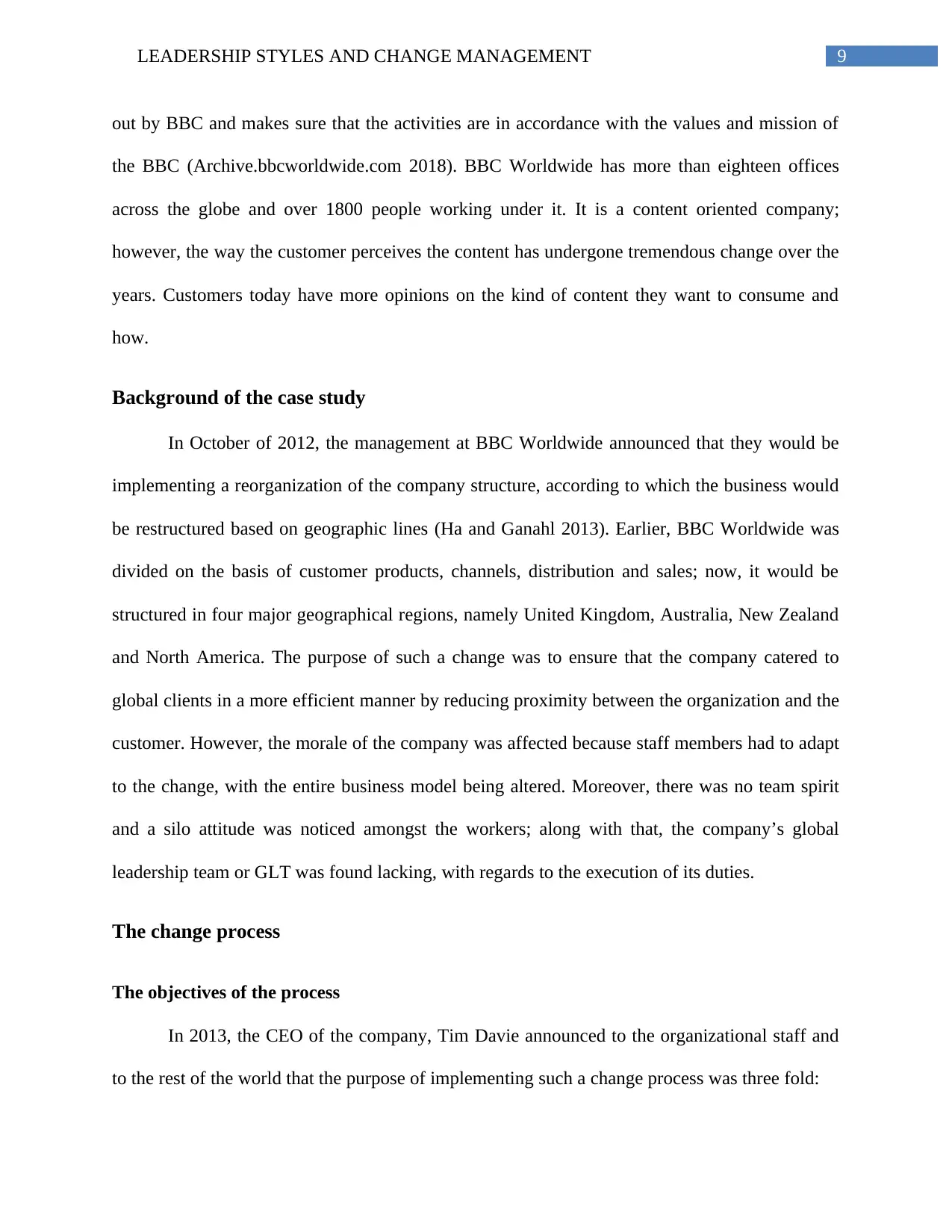
9LEADERSHIP STYLES AND CHANGE MANAGEMENT
out by BBC and makes sure that the activities are in accordance with the values and mission of
the BBC (Archive.bbcworldwide.com 2018). BBC Worldwide has more than eighteen offices
across the globe and over 1800 people working under it. It is a content oriented company;
however, the way the customer perceives the content has undergone tremendous change over the
years. Customers today have more opinions on the kind of content they want to consume and
how.
Background of the case study
In October of 2012, the management at BBC Worldwide announced that they would be
implementing a reorganization of the company structure, according to which the business would
be restructured based on geographic lines (Ha and Ganahl 2013). Earlier, BBC Worldwide was
divided on the basis of customer products, channels, distribution and sales; now, it would be
structured in four major geographical regions, namely United Kingdom, Australia, New Zealand
and North America. The purpose of such a change was to ensure that the company catered to
global clients in a more efficient manner by reducing proximity between the organization and the
customer. However, the morale of the company was affected because staff members had to adapt
to the change, with the entire business model being altered. Moreover, there was no team spirit
and a silo attitude was noticed amongst the workers; along with that, the company’s global
leadership team or GLT was found lacking, with regards to the execution of its duties.
The change process
The objectives of the process
In 2013, the CEO of the company, Tim Davie announced to the organizational staff and
to the rest of the world that the purpose of implementing such a change process was three fold:
out by BBC and makes sure that the activities are in accordance with the values and mission of
the BBC (Archive.bbcworldwide.com 2018). BBC Worldwide has more than eighteen offices
across the globe and over 1800 people working under it. It is a content oriented company;
however, the way the customer perceives the content has undergone tremendous change over the
years. Customers today have more opinions on the kind of content they want to consume and
how.
Background of the case study
In October of 2012, the management at BBC Worldwide announced that they would be
implementing a reorganization of the company structure, according to which the business would
be restructured based on geographic lines (Ha and Ganahl 2013). Earlier, BBC Worldwide was
divided on the basis of customer products, channels, distribution and sales; now, it would be
structured in four major geographical regions, namely United Kingdom, Australia, New Zealand
and North America. The purpose of such a change was to ensure that the company catered to
global clients in a more efficient manner by reducing proximity between the organization and the
customer. However, the morale of the company was affected because staff members had to adapt
to the change, with the entire business model being altered. Moreover, there was no team spirit
and a silo attitude was noticed amongst the workers; along with that, the company’s global
leadership team or GLT was found lacking, with regards to the execution of its duties.
The change process
The objectives of the process
In 2013, the CEO of the company, Tim Davie announced to the organizational staff and
to the rest of the world that the purpose of implementing such a change process was three fold:
Paraphrase This Document
Need a fresh take? Get an instant paraphrase of this document with our AI Paraphraser
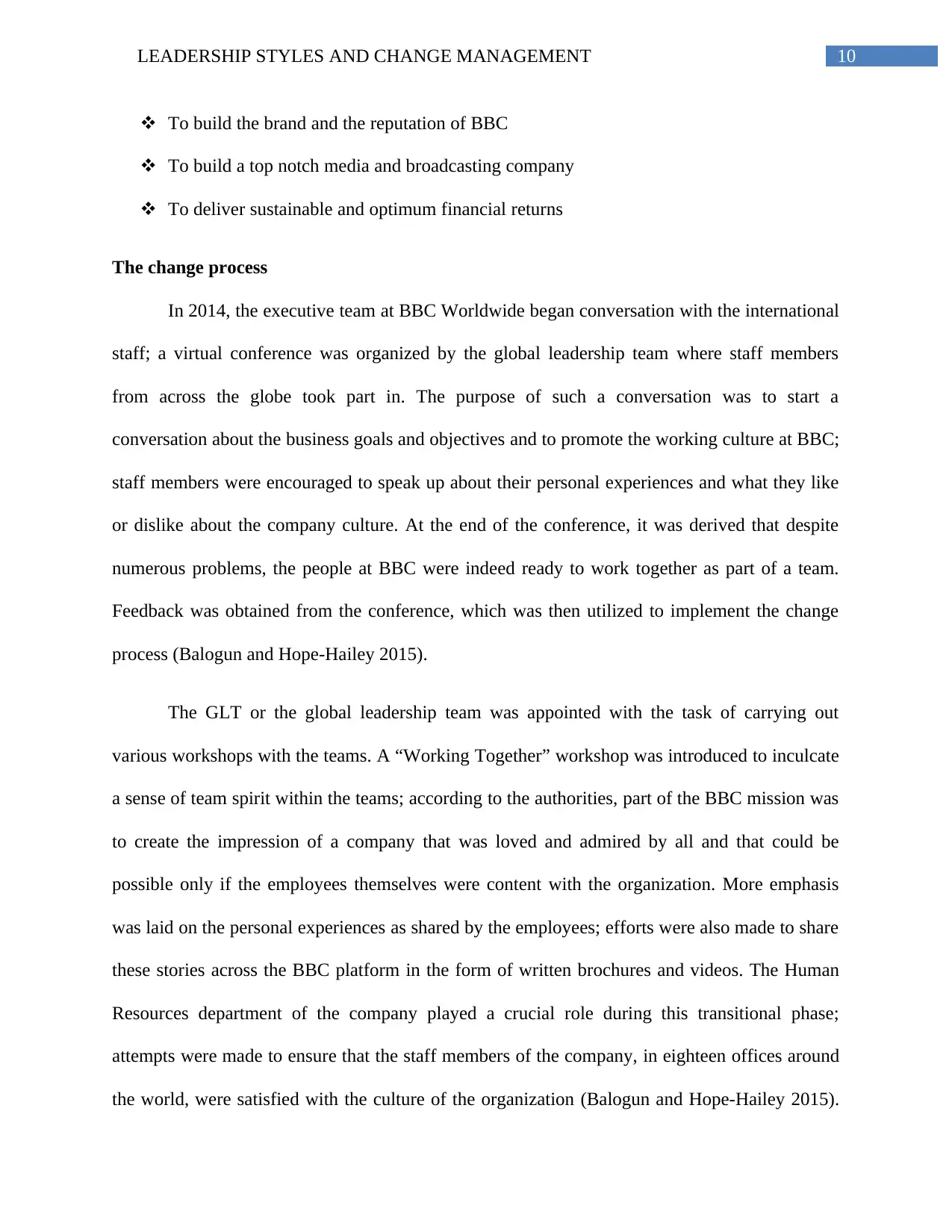
10LEADERSHIP STYLES AND CHANGE MANAGEMENT
To build the brand and the reputation of BBC
To build a top notch media and broadcasting company
To deliver sustainable and optimum financial returns
The change process
In 2014, the executive team at BBC Worldwide began conversation with the international
staff; a virtual conference was organized by the global leadership team where staff members
from across the globe took part in. The purpose of such a conversation was to start a
conversation about the business goals and objectives and to promote the working culture at BBC;
staff members were encouraged to speak up about their personal experiences and what they like
or dislike about the company culture. At the end of the conference, it was derived that despite
numerous problems, the people at BBC were indeed ready to work together as part of a team.
Feedback was obtained from the conference, which was then utilized to implement the change
process (Balogun and Hope-Hailey 2015).
The GLT or the global leadership team was appointed with the task of carrying out
various workshops with the teams. A “Working Together” workshop was introduced to inculcate
a sense of team spirit within the teams; according to the authorities, part of the BBC mission was
to create the impression of a company that was loved and admired by all and that could be
possible only if the employees themselves were content with the organization. More emphasis
was laid on the personal experiences as shared by the employees; efforts were also made to share
these stories across the BBC platform in the form of written brochures and videos. The Human
Resources department of the company played a crucial role during this transitional phase;
attempts were made to ensure that the staff members of the company, in eighteen offices around
the world, were satisfied with the culture of the organization (Balogun and Hope-Hailey 2015).
To build the brand and the reputation of BBC
To build a top notch media and broadcasting company
To deliver sustainable and optimum financial returns
The change process
In 2014, the executive team at BBC Worldwide began conversation with the international
staff; a virtual conference was organized by the global leadership team where staff members
from across the globe took part in. The purpose of such a conversation was to start a
conversation about the business goals and objectives and to promote the working culture at BBC;
staff members were encouraged to speak up about their personal experiences and what they like
or dislike about the company culture. At the end of the conference, it was derived that despite
numerous problems, the people at BBC were indeed ready to work together as part of a team.
Feedback was obtained from the conference, which was then utilized to implement the change
process (Balogun and Hope-Hailey 2015).
The GLT or the global leadership team was appointed with the task of carrying out
various workshops with the teams. A “Working Together” workshop was introduced to inculcate
a sense of team spirit within the teams; according to the authorities, part of the BBC mission was
to create the impression of a company that was loved and admired by all and that could be
possible only if the employees themselves were content with the organization. More emphasis
was laid on the personal experiences as shared by the employees; efforts were also made to share
these stories across the BBC platform in the form of written brochures and videos. The Human
Resources department of the company played a crucial role during this transitional phase;
attempts were made to ensure that the staff members of the company, in eighteen offices around
the world, were satisfied with the culture of the organization (Balogun and Hope-Hailey 2015).
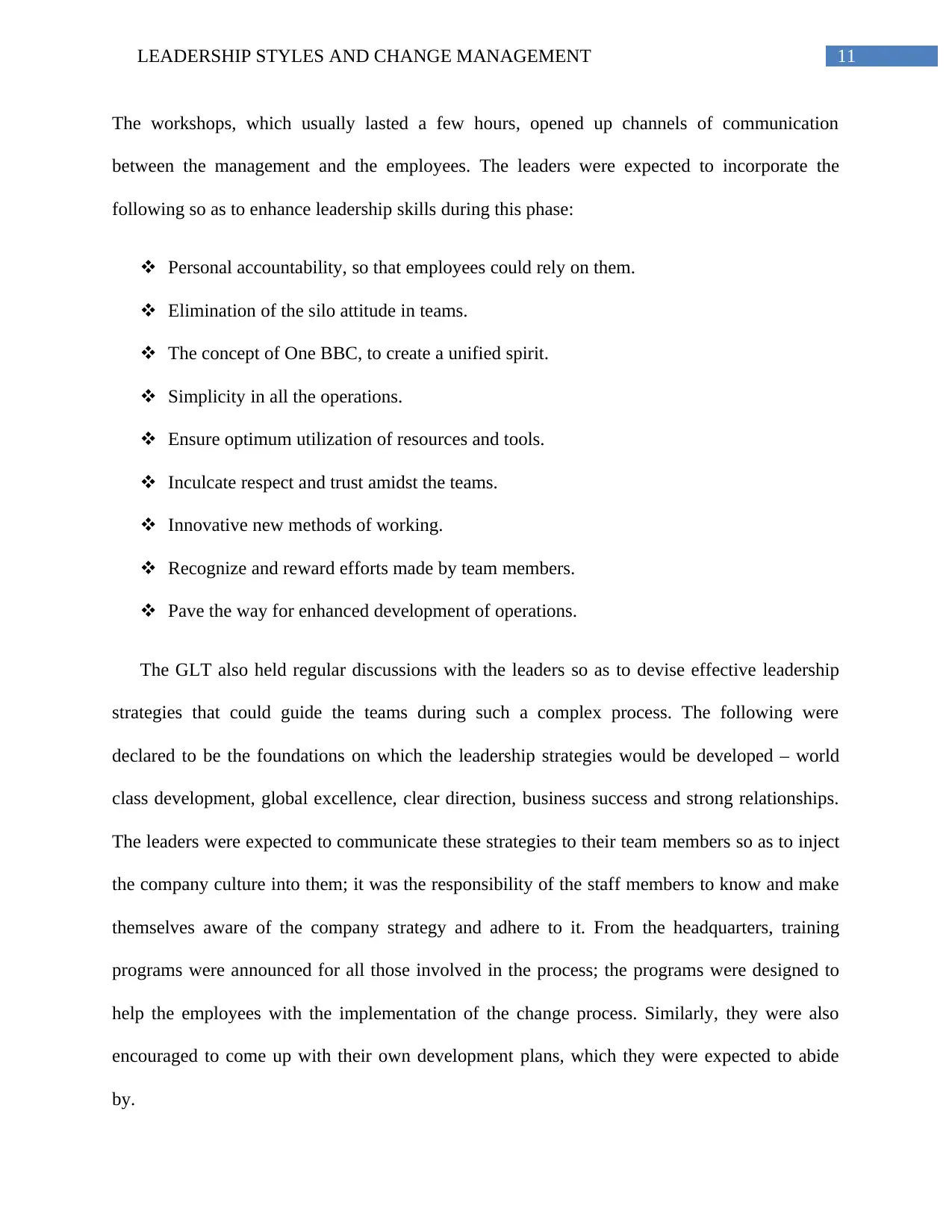
11LEADERSHIP STYLES AND CHANGE MANAGEMENT
The workshops, which usually lasted a few hours, opened up channels of communication
between the management and the employees. The leaders were expected to incorporate the
following so as to enhance leadership skills during this phase:
Personal accountability, so that employees could rely on them.
Elimination of the silo attitude in teams.
The concept of One BBC, to create a unified spirit.
Simplicity in all the operations.
Ensure optimum utilization of resources and tools.
Inculcate respect and trust amidst the teams.
Innovative new methods of working.
Recognize and reward efforts made by team members.
Pave the way for enhanced development of operations.
The GLT also held regular discussions with the leaders so as to devise effective leadership
strategies that could guide the teams during such a complex process. The following were
declared to be the foundations on which the leadership strategies would be developed – world
class development, global excellence, clear direction, business success and strong relationships.
The leaders were expected to communicate these strategies to their team members so as to inject
the company culture into them; it was the responsibility of the staff members to know and make
themselves aware of the company strategy and adhere to it. From the headquarters, training
programs were announced for all those involved in the process; the programs were designed to
help the employees with the implementation of the change process. Similarly, they were also
encouraged to come up with their own development plans, which they were expected to abide
by.
The workshops, which usually lasted a few hours, opened up channels of communication
between the management and the employees. The leaders were expected to incorporate the
following so as to enhance leadership skills during this phase:
Personal accountability, so that employees could rely on them.
Elimination of the silo attitude in teams.
The concept of One BBC, to create a unified spirit.
Simplicity in all the operations.
Ensure optimum utilization of resources and tools.
Inculcate respect and trust amidst the teams.
Innovative new methods of working.
Recognize and reward efforts made by team members.
Pave the way for enhanced development of operations.
The GLT also held regular discussions with the leaders so as to devise effective leadership
strategies that could guide the teams during such a complex process. The following were
declared to be the foundations on which the leadership strategies would be developed – world
class development, global excellence, clear direction, business success and strong relationships.
The leaders were expected to communicate these strategies to their team members so as to inject
the company culture into them; it was the responsibility of the staff members to know and make
themselves aware of the company strategy and adhere to it. From the headquarters, training
programs were announced for all those involved in the process; the programs were designed to
help the employees with the implementation of the change process. Similarly, they were also
encouraged to come up with their own development plans, which they were expected to abide
by.
⊘ This is a preview!⊘
Do you want full access?
Subscribe today to unlock all pages.

Trusted by 1+ million students worldwide
1 out of 17
Related Documents
Your All-in-One AI-Powered Toolkit for Academic Success.
+13062052269
info@desklib.com
Available 24*7 on WhatsApp / Email
![[object Object]](/_next/static/media/star-bottom.7253800d.svg)
Unlock your academic potential
Copyright © 2020–2025 A2Z Services. All Rights Reserved. Developed and managed by ZUCOL.




